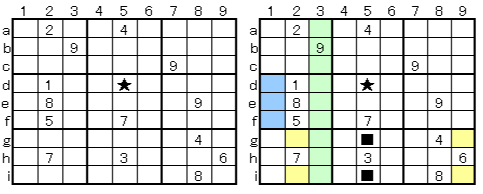Sudoku and Solver
Sudoku and Solver
Beginner
Here we review the basics that arise from the rules of the Sudoku. Many beginner's samples are relatively simple and can usually be solved in about 5 to 15 minutes.
*Basic rule 1
The numbers in an area limit the columns and rows that belong to the same area.
5 of E (5f) is restricted so that 5 does not fit in E area, vertical row 5 and horizontal column f.
*Basic rule 2
The numbers in one area are subject to the restrictions of the other areas.
6 in C (9 c), E (4 e) and H (6 g) determine ★ B (5 b) 6.
*Basic rule 1 *Basic rule 2

If you understand this, you can do the three techniques of the beginner class to solve the Sudoku.
1.B Technique 1 (Fill in the sideways)
The basics of Sudoku are that the numbers of one area are subject to the restrictions of the other areas, so it is a form of a side effect that uses numbers to fill in the numbers on each empty cells. You can scan from any number, from anywhere, but the recommendation is ...
1.Start to scan number 1
2.Scan rows 9 to row 1 (from right to left)
3.Next scan column1 to column 9 lines (from top to bottom)
4.After scanning 1 then scan 2 to 9
5.When the first whole scan is finished, do the same as the second time
6.If there are no numbers that can be entered even after the entire scan, the vertical and horizontal entry ends
(Note) If you can enter 8 numbers in the area, row and column on the way, fill in the remaining numbers at that time

Due to yellow C (8a) and green B (4b), A (3c) 's ★ only contains 4.
2.B Technique 2 (Skewer or kushizashi)
The B techniques 2 and 3 are powerful ones that complement the B technique 1 (Fill in the sideways). In the following sample, there are only 2 at 9 blue columns in area F due to green C (7c), so ★ of area I (8h) is determined to be 2.


The following example is a bit more complicated, but it is an application of a skewer. In this state, ★ is determined to be 9. Yellow G (2g) and G (2i) that can be skewered in area D and have 9 in G are possible. In area I, it is I (9g) and I (9i) that 9 may enter. If 9 enters in which direction, 9 enters in the other. Therefore, there is no possibility that 9 will be entered in the H area. Therefore, ★ in row 5 enters 9.
 ★⇒9
★⇒93.B Technique 3 (Hidden Skewer or kushizashi) (Note) Also called "Hidden Laser".
This is also used frequently in the technique that can be said to be an application example of a skewer. Due to the 6 in yellow E (6e) and green A (3b), there are only 2 blue rows available for 6 in area D. Therefore, 6 is determined in ★ of G(1h).

The frequency of use of this B technique 3 is high, and it is often used in the beginner class. We will focus on the A(3c) ★. There are 6 in the yellow a line. Because green E (6d) is 6, 6 does not fit into B (6b). We are hiding in the area B. If you scrutinize by entering the number of the beginner class, the number in the 3 columns is 125678. Although there is only 16 possibilities if you pay attention to ★, ★ is decided to be 1 because it does not enter 6 due to hidden laser.
 ★⇒1
★⇒1Let's check the beginner's technique with the actual example.
*Sample for Beginner


This sample can be solved instantaneously (0,05seconds) as beginner level in Sudoku Solver.

If you understand this, please proceed to the next intermediate class !